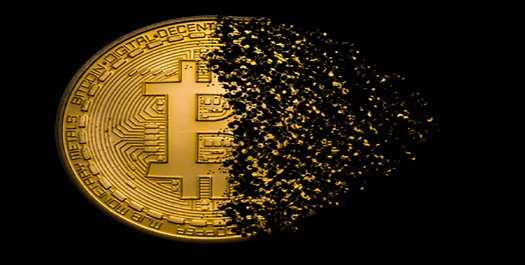The recent bitcoin plunge has been a painful lesson in market bubbles. In fact, a predictable flight to safety seems to have begun.
Across the globe, Bloomberg reports that bullion dealers are seeing a surge in gold buying since bitcoin lost more than 40% of its value this month. And it wasn’t only bitcoin: Ripple was down 50% and Ethereum down 30%.
Believe it or not, $300 billion was recently wiped from cryptocurrency fortunes in just 36 hours!
According to Bloomberg analyst Edward van der Walt, “the current price swings across seemingly every cryptocurrency are bringing to the fore a question that has loomed over the industry since its inception: to what extent can a virtual asset be a store of value? By swapping out of digital gold and into the real thing, some investors may be providing an answer.”
BITCOIN PLUNGE
Last month, a research study published by the Journal of Monetary Economics concluded that bitcoin had been the subject of massive price manipulation. They reported four scary points every retirement investor should consider before thinking about bitcoin:
1.Suspicious trades on a bitcoin currency exchange are linked to rises in the exchange rate
2. A single trader likely drove the USD/BTC exchange rate from $150 to $1000 in 2 months
3. Trading volume on all exchanges have increased greatly on days with suspicious activity
4. Unregulated cryptocurrency markets remain vulnerable to manipulation today
One dealer interviewed said he believes physical gold’s potential advantages are more apparent now to bitcoin buyers because there are “no passwords you can lose, the volatility is much lower, sustainable growth and in the end you can hold your investment in your hands.”
Last month, Goldman Sachs researcher Jeffrey Currie and analyst Michael Hinds compared gold with bitcoin. When evaluated closely on the key characteristics of money: liquidity, safety, utility and tradability, they argued that gold would be a more appealing choice to consider.
2018 GOLD REPORT: 3 GLOBAL TRENDS YOU MUST WATCH
In 2017, investors bought gold as uncertainty rose, incomes increased and gold’s momentum was sustained.
Gold rose 13.5%, enjoying its best year since 2010.
This month, the World Gold Council’s Outlook 2018 report came out, revealing market signals from across the entire gold industry. They say there are three key market trends for retirement investors to watch this year:
1.Stratospheric stock markets could spark safe haven demand: In 2017, asset prices hit multi-year highs, with the S&P 500 at an all-time high. Investors have been engaged in a game of chicken with the markets, taking on additional risks to generate additional returns. The WGC says if global financial markets suddenly start to correct, investors could seek additional exposure to gold as it has historically performed as a safe haven asset in periods of financial distress.
2.Global economic growth could drive diversification demand: Ten years after the 2008 financial crisis, the world is returning to economic normality. U.S. and European economies have expanded with rising wages, higher optimism and lower unemployment. China, the world’s largest gold market, is moving gradually to a consumption-led economy and India’s economy, the second largest gold market in the world, is becoming more transparent. The WGC expects increased global consumer demand to support the investment case for gold. Also, they believe gold’s low correlation with other mainstream financial assets makes gold and silver bullion both an effective and attractive diversifier.
3.Rising rates and shrinking central bank balance sheets: Continued global economic expansion will likely result in tighter monetary policy in the coming year. The WGC thinks that higher rates could create financial market volatility and possibly raise the appeal of physical precious metals as a diversifier and safe haven asset.
The WGC believes these trends could provide more demand for gold and maintain bullion’s relevance in portfolios like Gold IRAs as a safe haven asset. WGC notes that gold has provided competitive returns over the long run, growing by 10% on average since 1971.
CONSIDER OWNING GOLD, SAY THESE INVESTMENT PROS
Frank Holmes thinks having a portion of a portfolio in gold is worth considering because gold exploration budgets keep getting cut and he believes gold could be a bargain compared to stocks. Moreover, Holmes argues that higher debt could mean higher gold prices, Fed tightening could induce a recession and demand for gold from China and India remains robust.
Senior portfolio manager John Hathaway recently wrote that an allocation to physical gold could reduce downside exposure during periods of market stress and exposure to gold could be a good strategy to consider to help protect your capital.
Bloomberg Intelligence commodity strategist Mike McGlone wrote this past week that “inflows indicate a gold market that continues to gain favor despite rapidly increasing financial assets.” According to McGlone, gold is demonstrating strength and could benefit if the stock markets reverse and slide.
Bloomberg’s David Fickling recently completed an analysis indicates gold price changes could have a seasonal component. According to Ficking, January, February. July and August are the four months this year when the metal has rallied most strongly. These have, on average, been the best months to buy gold over the previous 10 years.
WHAT LEGACY WILL YOU LEAVE?
A financial legacy isn’t built with flash-in-the-pan thinking. Whatever the month, owning physical gold and silver could help hedge your risk in case of a financial market downturn.
The recent short U.S. government shutdown, record stock market values and global political unrest should not be ignored. Gold and silver are safe haven assets that could help mitigate risk.
Gold has more than a 4,000-year history of value, portability and safe haven asset status. Something to consider when building a retirement portfolio that will stand the test of time – through good times and bad.
It could be the perfect time to take more control over your financial future with physical precious metals.






